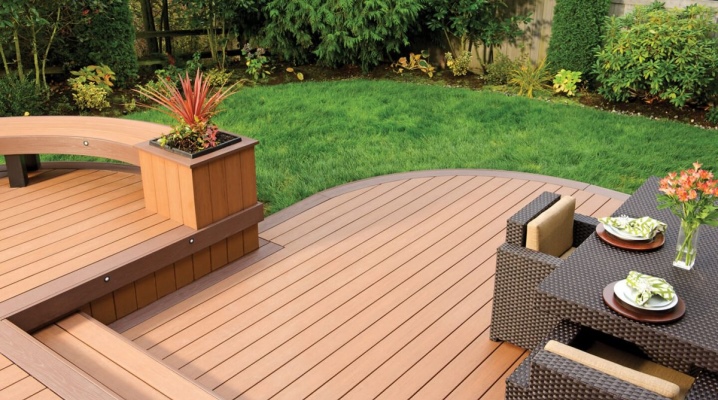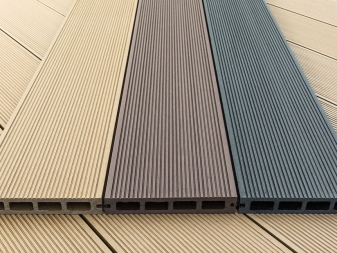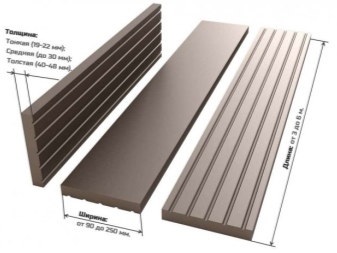What is decking and where is it used?

In the modern building materials market, a wide selection of options for decorating the local area is offered. If you have long dreamed of a beautiful terrace, but do not see the point in using wood outdoors, as it lends itself to moisture, there is a great alternative. We are talking about WPC decking, which is in great demand. This material has a lot of positive characteristics and its advantages, which should be learned in more detail.



Features, pros and cons
WPC decking is called decking, which translates from English as "deck flooring". Initially, the material was used exclusively on decks. A distinctive feature is that on the front surface there are long ribs along which water flows. As you know, this is extremely necessary on decks, moreover, thanks to this feature, the board will not be too slippery in the rain.
Wood is one of the most popular materials and looks presentable, but it is not suitable for outdoor use for a number of reasons. Therefore, an alternative option is decking, which has many advantages. First of all, it does not require serious maintenance, in order to remain presentable for a long time, it is enough to carry out a simple cleaning. Working with this product is many times easier, because it lends itself to drilling and cutting with a simple tool. The rest of the advantages include the appearance, which today is offered in different versions.

WPC building material has durability, practice shows that a product made of such material can last up to 25 years, however, this is in view of the fact that the product has accompanying documents from the manufacturer. Decking easily copes with difficult conditions, it is not afraid of too high or low temperatures. In order to maintain the same appearance, it is recommended to carry out intensive cleaning annually, and this will be enough. Of course, if the material is light, it requires more maintenance, but it does not take much time.

The intensity of the shade remains for a long time, but if the product from the decking is outside, where the sun regularly beats, it may fade over time, and the color will change somewhat. The more wood is in the composition, the more natural the final structure will look. It should be noted that the material does not absorb moisture, so the problem of swelling will not bother. It is also a great advantage that the decking will not change the geometry, moreover, it will not start to rot, and the fungus will not appear at all. As you can see, there are a lot of advantages, but before choosing such a material, you should find out about the disadvantages that also exist.


None of the finishing materials can be called perfect, and the decking was no exception. Some varieties will require a special mount. Another disadvantage is that the building material does not tolerate water very well, so it can be wetted, but it is important to ensure that moisture does not stagnate. When it comes to non-continuous flooring, this problem is easily solved, since there are gaps between the boards.


More than half of the WPC consists of natural wood, so its strength differs from that of tile or stone material. This means that hitting the material and dropping something heavy on it is not recommended. The board can crack under heavy load or leave a dent on it, so this disadvantage should be taken into account.


Views
The material consists of wood flour and binder polymer. WPC is offered in several versions, which differ not only in appearance, but also in operational characteristics. The soft deck is produced from a plastic backing that increases the ventilation properties of the material. Such a covering is called garden parquet; beautiful gazebos, terraces and even baths are obtained from it. It can be produced as a board or tile in various sizes and thicknesses.

Materials (edit)
Made of wood
Solid wood is a natural raw material that is suitable for making wooden boards. For this, different breeds are used, many of which are even specially brought from other countries. The unique texture is pleasing to the eye and will favorably decorate the interior and landscape design. Natural decking is in high demand, although it requires a lot of maintenance and is offered at a high price.
You can also find decking made of thermally treated wood on the market. This procedure slightly changes the color of the material, but increases the resistance to decay and decay. The material can last for about 20 years, which is a great advantage.
It should be noted that this is a soft decking, so it should be used in places where there will be no significant loads.


Many manufacturers use larch, pine species to create high-quality and beautiful decking. High-quality boards are produced from thermo-ash, which are suitable for finishing work. It is safe to say that thermowood is a good material with increased resistance to moisture and atmospheric influences.

WPC
This is an unusual material that is highly durable. For its manufacture, sawdust and a polymer substance are used. Such garden parquet has a beautiful decor, it is practical, as it is highly resistant to various damages. The material will last a long time, moreover, it is offered at an affordable price.


Plastic decking is popular due to its budget and ease of installation. In addition, the material does not decay, does not grow moldy and remains attractive for many years. The product has absolute moisture resistance, so it is often used for finishing near basements or water bodies. The market offers a wide range of colors.
The composite deck is rot-resistant and does not chip or burr. The material will not crack, burn and is environmentally friendly. It is very easy to work with composite, the same goes for editing.



Texture and color scheme
The decorative data of building materials from WPC and solid wood are very different. A natural wood decking conveys a natural texture and natural shade, but manufacturers can paint it in any color that is typical for lumber. As for the WPC, it has a limited palette, the colors will be saturated, but not natural-looking, although many like the fact that you can find an unusual color.
The front surface of solid wood or WPC decking can be either smooth or corrugated, so here they are the same. The market offers a wide selection of decking, it is classic white, black and gray, but many are attracted by bright shades, for example, green, red, burgundy, honey.



Dimensions (edit)
It is worth noting that the decking is not offered in standard uniform sizes, so everyone can choose anything that suits their personal requirements. In addition, manufacturers have their own boundaries and views on the optimal size. but an important parameter of any WPC board is thickness, while this indicator includes the thickness of the partition and the front layer. Thanks to this, the product becomes durable and durable.
If we talk about hollow deck composite board, you can find material on the market with a thickness of 19-32 mm, as well as a width of 13-26 cm. Planks with such parameters are often on sale - 300x300 and 1000x1000, although there are much more options. It is important to note that dimensions directly affect the weight of the material.


Applications
The decking's resistance to water won over many users. The modular material is actively used near garden and park areas, around swimming pools, in saunas and baths. It is not only an outdoor building material, but also suitable for indoor applications.
If we talk about the version with grooves, such a coating is used as a decoration for balconies, loggias, a special demand for it in Japan. Paths in gardens are lined with this material, gazebos are made of it, railings to porches are created, and even walls are made of it.



Thus, decking is used in a wide variety of places where aesthetic qualities and high strength are required. If you want to equip a gazebo, make a decorative bridge or clad a house in the country, you can safely choose this material that meets strict requirements and will serve for a long time, while maintaining a presentable appearance. This product is also better suited as a floor covering than ordinary wood, as it resists abrasion, does not require long-term care and expensive maintenance.
It should be noted that the board is often used during the construction of sliding gates, as it is excellent for cladding. Of course, initially the material was considered facade, as it was created for finishing decks, so it can often be found in holds and cabins, as well as in other similar places. Undoubtedly, decking can be called universal, because it is used outdoors - verandas, balconies, terraces, and indoors - floors, saunas, etc.


How to choose?
You should not immediately rush to a low price, as the presented product may turn out to be a fake. First you need to carefully study the material, learn about its main characteristics, type and other properties. There are several criteria that will help you find quality styling products.
- Pay attention to the homogeneity of the structure - there should not be different areas on the surface. If the edges are even and clear, and the lintels are of the same thickness, you can safely consider this option.
- There should be no defects, cavities or lumps on the board. You should inspect the material from all sides, including the sides and bottom edge - if there is waviness on it, you cannot buy it, since you will face a lot of problems during installation.
- The presence of crumbs and delamination indicates poor product quality. Check the WPC for strength: just try to break off a small piece on the cut, if you have something left in your hands, it is better to continue looking for another manufacturer.
- Companies that have proven themselves in Russia offer a wide palette, in which there will certainly be light shades, which indicates the use of high-quality wood. If you see only dark colors in the catalog, there is no doubt that the company uses waste, so you can not expect good properties from the material.
- The shape of the edge can be beveled, straight and rounded, so when searching, be guided by the laying technology, since in some situations you will need an expensive base.
- The surface of the front side also influences the choice - for example, for open areas near showers, it is better to choose a raised deck for increased safety, although it is much easier to care for a smooth one.
- The density parameter can be called key, so consider the potential load. If the material is intended for flooring, make sure it is high.
- The decking profile can be monolithic or have stiffening ribs.

Mounting methods
There are two ways to mount the deck. In the open method, the material must be screwed through the face with screws through and through to create the effect of a riveted board. This type of installation is recommended for interiors with Provence, Loft and Country styles. You should choose anti-corrosion self-tapping screws and first make holes where the screw will be screwed.
Closed mounting is carried out with special clips, they must be attached to the board, and then to the lags. When it comes to solid wood, this is the best way to go. Laying will make the material aesthetically pleasing, but the work will take longer.
Some types of lags have grooves in which you can place rubber clips. This is the optimal solution for periods of expansion of the material under the influence of elevated temperatures. Due to these grooves, the same gaps are created throughout the decking.


The subtleties of styling
If you decide to carry out the installation yourself, it is recommended to study the advice of specialists so that the result is positive.
- First you need to prepare the base - here you can use dense soil, gravel, concrete or wood. The main condition is to ensure density, therefore, whichever material you choose, tamp it so that the boards do not fall through. It is important to clear the area from pollution and all kinds of debris.
- During installation, it is necessary to equip supports made of gravel or agrotextile.
- Then, using a tape measure, a cord and a peg, markings are made in order to calculate the placement of the material according to the selected pattern. Consider in advance the number of sections along which the parquet will be located.
- If there is a slight slope, spread from the highest point and follow the direction of the slope to ensure proper drainage of rainwater.
- Use a regular hacksaw to remove corners that protrude beyond the boundaries.


As you can see, you can do the styling with your own hands, you need simple tools, and they can be found in the house of every owner. If a defect is found, dismantling can be carried out in order to redo the installation and once again think over the position of the slabs.
Considering all the listed characteristics and features of the products, as well as paying attention to the recommendations, you can find any type of decking for outdoor or indoor use. This material has earned widespread recognition for its aesthetic and performance properties.



For the types of decking, see the next video.













The comment was sent successfully.